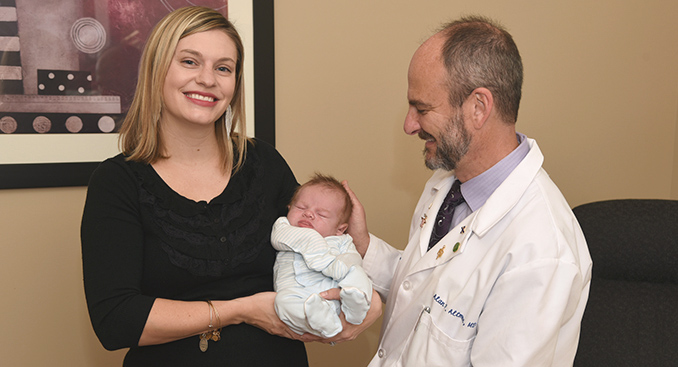How TriHealth is Reducing C-Sections

TriHealth physicians are tackling a long-standing problem: the high percentage of babies born by Cesarean section in the United States. According to the Centers for Disease Control, nearly a third of the nation’s babies are born by C-section. In individual states, the rate for this surgery varies from a low of 22.8 percent in Utah to a high of 38 percent in Mississippi. Ohio’s rate is 30.4 percent.
C-sections can be life-saving for both mothers and babies. However, C-sections are major abdominal surgeries, and complications can occur in C-sections that are not seen in vaginal deliveries. Also, the recovery is longer and can be more complicated. Avoiding a C-section that is not absolutely medically necessary, especially for first time mothers, is thought to be the best option for both mothers and babies.
Alan Altman, MD, an OB/GYN with TriHealth Women's Services, is working to decrease the C-section rate for TriHealth patients. “In order to create awareness,” he says, “we’ve been periodically publishing the C-section rate of every OB physician on our staff in a blinded fashion. We put everyone’s C-section percentage on a graph, and each physician receives a copy with their individual percentage highlighted. They can then compare their rate to all other TriHealth OB physicians.”
Dr. Altman explains that bringing attention to the issue makes physicians think: “If my rate is on the higher end, what are others doing to have lower rates?” They then talk to other doctors, asking about methods, practices and strategies that can help them bring their rates down.
“Having this data also makes doctors think twice when considering a C-section,” says Dr. Altman. “Certainly, there are cases where a C-section is necessary, but there are also those times when, if you just gave the mother more time to labor, perhaps she could have a successful vaginal delivery!”
TriHealth’s efforts have been working. “It absolutely has made a difference,” says Dr. Altman. “We have pulled the C-section rate down.” In 2015 before the reporting program started, the C-section rate at TriHealth for first-time mothers was 36 percent. After the program was implemented, the rate dropped to 26.9 percent in 2016. For 2017, the rate through September is 24.6 percent.
Two TriHealth patients recently avoided C-sections with Dr. Altman’s help. Billie Elam was a first-time mom who was induced to begin her labor. Things were going alright at first. “All of a sudden, there were about six people in the room because the baby’s heart rate kept dropping,” says Billie. “They told me to be prepared for a possible C-section.”
However, the efforts of the TriHealth staff helped Billie avoid a C-section. “The nurses were suggesting things like moving me around. I didn’t want to have a C-section, so I was glad they tried all these things to avoid it,” she says.
After successfully giving birth vaginally, Billie had nothing but good things to say about the nurses, doctors and staff at Bethesda North Hospital. “Everybody was really great. The nurses were so nice. They have a really good team of people,” she says.
The experience Billie had with her first birth was in stark contrast to that of Tina Beis, who delivered her first child in another area of Ohio. She had an emergency C-section under general anesthesia. “It was a pretty traumatic birth experience, and the recovery was very hard,” recalls Tina. “With my second pregnancy, I just assumed I’d do a C-section because of my previous one.”
However, Tina went into labor a couple of days before her scheduled C-section. Dr. Altman was on call and explained to her that she could try a VBAC, or a vaginal birth after C-section. He told Tina and her husband what the risks were, and that her chance of success was 70 percent.
“We decided to go for it,” she says. “The staff kept me at ease, and because of Dr. Altman’s confidence and the statistics he provided, he made me feel much better. And we just kind of trusted in his judgement.”
Tina says the birth experience and recovery were much different than her first delivery. “My husband was able to be by my side the whole time,” she recalls. “To actually be aware and experience everything, that moment of seeing your baby come into the world, was really great. And this time, I was up and walking around the next day, able to go up and down stairs and drive, which were all things I couldn’t do after my C-section.”
“Ultimately,” says Dr. Altman, “I want delivering mothers to have the safest and highest quality birth experience possible, and at TriHealth, we believe that safely increasing the vaginal delivery rate improves the birth experience.”